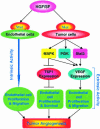Hepatocyte growth factor/scatter factor mediates angiogenesis through positive VEGF and negative thrombospondin 1 regulation
- PMID: 14555767
- PMCID: PMC240684
- DOI: 10.1073/pnas.2135113100
Hepatocyte growth factor/scatter factor mediates angiogenesis through positive VEGF and negative thrombospondin 1 regulation
Abstract
Hepatocyte growth factor/scatter factor (HGF/SF), acting through the Met receptor, plays an important role in most human solid tumors, and inappropriate expression of this ligand-receptor pair is often associated with poor prognosis. The molecular basis for the malignant potential of the HGF/SF-Met signal in cancer cells has mostly been attributed to its mitogenic and invasive properties. However, HGF/SF also induces angiogenesis, but the signaling mechanism has not been fully explained, nor has this activity been directly associated with HGF/SF-Met-mediated tumorigenesis. It is known that HGF/SF induces in vitro expression of vascular endothelial growth factor (VEGF), a key agonist of tumor angiogenesis; by contrast, thrombospondin 1 (TSP-1) is a negative regulator of angiogenesis. Here, we show that, in the very same tumor cells, in addition to inducing VEGF expression, HGF/SF dramatically down-regulates TSP-1 expression. We show that TSP-1 shut-off plays an important, extrinsic role in HGF/SF-mediated tumor development, because ectopic expression of TSP-1 markedly inhibits tumor formation through the suppression of angiogenesis. Interestingly, although VEGF-induced expression is sensitive to inhibitors of several pathways, including mitogen-activated protein kinase, phosphoinositide 3-kinase, and signal transducer and activator of transcription 3, TSP-1 shut-off by HGF/SF is prevented solely by inhibiting mitogen-activated protein kinase activation. These studies identify HGF/SF as a key switch for turning on angiogenesis. They suggest that TSP-1 is a useful antagonist to tumor angiogenesis and that it may have therapeutic value when used in conjunction with inhibitors of VEGF.
Figures





Similar articles
-
Cyclooxygenase-2-selective nonsteroidal anti-inflammatory drugs inhibit hepatocyte growth factor/scatter factor-induced angiogenesis.Cancer Res. 2003 Dec 1;63(23):8351-9. Cancer Res. 2003. PMID: 14678996
-
HGF/NK4, a four-kringle antagonist of hepatocyte growth factor, is an angiogenesis inhibitor that suppresses tumor growth and metastasis in mice.Cancer Res. 2000 Dec 1;60(23):6737-43. Cancer Res. 2000. PMID: 11118060
-
Hepatocyte growth factor/scatter factor-induced activation of MEK and PI3K signal pathways contributes to expression of proangiogenic cytokines interleukin-8 and vascular endothelial growth factor in head and neck squamous cell carcinoma.Cancer Res. 2001 Aug 1;61(15):5911-8. Cancer Res. 2001. PMID: 11479233
-
Scatter factor/hepatocyte growth factor in brain tumor growth and angiogenesis.Neuro Oncol. 2005 Oct;7(4):436-51. doi: 10.1215/S1152851705000050. Neuro Oncol. 2005. PMID: 16212809 Free PMC article. Review.
-
Scatter factor/hepatocyte growth factor (SF/HGF) content and function in human gliomas.Int J Dev Neurosci. 1999 Aug-Oct;17(5-6):517-30. doi: 10.1016/s0736-5748(99)00008-8. Int J Dev Neurosci. 1999. PMID: 10571413 Review.
Cited by
-
Combined transfer of human VEGF165 and HGF genes renders potent angiogenic effect in ischemic skeletal muscle.PLoS One. 2012;7(6):e38776. doi: 10.1371/journal.pone.0038776. Epub 2012 Jun 13. PLoS One. 2012. PMID: 22719942 Free PMC article.
-
Exploring angiogenic pathways in breast cancer: Clinicopathologic correlations and prognostic implications based on gene expression profiles from a large-scale genomic dataset.PLoS One. 2024 Sep 20;19(9):e0310557. doi: 10.1371/journal.pone.0310557. eCollection 2024. PLoS One. 2024. PMID: 39302921 Free PMC article.
-
Ovarian cancer: emerging molecular-targeted therapies.Biologics. 2012;6:147-54. doi: 10.2147/BTT.S24155. Epub 2012 Jun 20. Biologics. 2012. PMID: 22807625 Free PMC article.
-
Comment on "Effect of transferred NK4 gene on proliferation, migration, invasion, and apoptosis of human prostate cancer DU145 cells" by Dan Yue et al. in Asian Journal of Andrology.Asian J Androl. 2010 May;12(3):444-6. doi: 10.1038/aja.2010.26. Epub 2010 Apr 19. Asian J Androl. 2010. PMID: 20400970 Free PMC article. No abstract available.
-
Current status and perspective of antiangiogenic therapy for cancer: urinary cancer.Int J Clin Oncol. 2006 Apr;11(2):90-107. doi: 10.1007/s10147-006-0565-6. Int J Clin Oncol. 2006. PMID: 16622744 Review.
References
-
- Trusolino, L. & Comoglio, P. M. (2002) Nat. Rev. Cancer 4 289–300. - PubMed
-
- Vande Woude, G. F., Jeffers, M., Cortner, J., Alvord, G., Tsarfaty, I. & Resau, J. (1997) CIBA Found. Symp. 212 119–132. - PubMed
-
- Hanahan, D. & Weinberg, R. A. (2000) Cell 100 57–70. - PubMed
-
- Hanahan, D. & Folkman, J. (1996) Cell 86 353–364. - PubMed
-
- Ferrara, N. (2002) Semin. Oncol. 29 10–14. - PubMed
Publication types
MeSH terms
Substances
LinkOut - more resources
Full Text Sources
Other Literature Sources
Medical
Miscellaneous

